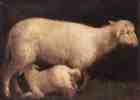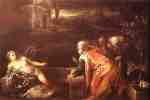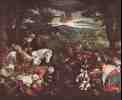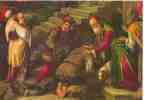![]()
Bassano, Jacopo (Jacopo da Ponte) (b. c.1510-18, Bassano del Grappa; d. 1592, Bassano). Italian painter, the most celebrated member of a family of artists who took their name from the small town of Bassano, about 65 km. from Venice.
Apart from a period in the 1530s when he trained with Bonifazio Veronese in Venice, Jacopo worked in Bassano all his life. His father, Francesco the Elder (c.1475-1539), was a village painter and Jacopo always retained something of the peasant artist, even though the influence of, for example, the fashionable etchings of Parmigianino is evident in his work.
Even though most of his career was spent in small or middle-sized towns on the mainland, he always remained alert to the latest developments in art, sometimes borrowing details from Lorenzo Lotto's works in his portraits. A pioneer in genre scenes and landscape painting, engravings were critical in forming Jacopo's style, particularly those by and after artists like Albrecht Dürer, Raphael, and Parmigianino.
By 1534 he had found his direction in the art of nearby Venice, learning as much from the chiaroscuro and luxurious color of Titian's works as from his teachers. He won some renown in Venice itself, and became one of the Veneto's most influential painters in the mid-1500s.
He also had the ability to devise new ideas for compositions that possessed great force of expression. Trained in his father's studio, Jacopo broke away from the local popular and devotional tradition by studying prints by Raphael and developments in Mannerism. His early Mannerist works used elongated figures and brilliant colors. During the 1540s his painting was experimental, the anatomy of his characters was forced and their postures unnatural. This phase proved crucial in the development of his own very personal style which was capable of assimilating new ideas and translating them into an art with enormous communicative power. Jacopo Bassano's popular realism was underpinned by his exceptional use of light and characterized by the lifelike quality of the people and details, especially the animals, in his pictures. Local taste required that art illustrate reality, and Jacopo drew inspiration from the simple human scenes, farm life, and changing aspects of nature he observed in his hometown. To Mannerism's energy, extreme movement, and tightly compressed space, he added realism and earthiness. A humble and subtle observer, his sitters may seem unaware of his presence. Increasingly, he used religious and philosophical subjects as pretexts for painting genre scenes and landscapes.
Over the years his oeuvre became increasingly grand and dramatic, starting with a series of altarpieces (in Bassano, Treviso, Padua, and Belluno) whose production dates from the 1550s through to the end of his career.
He treated biblical themes in the manner of rustic genre scenes, using genuine country types and portraying animals with real interest. In this way he helped to develop the taste for paintings in which the genre or still-life element assumes greater importance than the ostensible religious subject. From around 1560 his work became vested with a more exaggerated search for novel effects of light, taking on something of the iridescent coloring of Tintoretto.
Bassano had four painter sons who continued his style -- Francesco the Younger (1549-92), Gerolamo (1566-1621), Giovanni Battista (1553-1613), and Leandro (1557-1622). Francesco (who committed suicide by throwing himself out of a window) and Leandro both acquired some distinction and popularity working in Venice. Jacopo's workshop was a minor industry in Bassano, and his four sons continued his style into the next century. The work of the family is well represented in the Museo Civico at Bassano.
 The Annunciation to the Shepherds
The Annunciation to the Shepherds
1533;
Oil on canvas;
Belvoir Castle, Leicestershire, England
 Madonna and Child with Saints
Madonna and Child with Saints
1545-50;
Oil on canvas, 191 x 134 cm;
Alte Pinakothek, Munich
The altarpiece, representing the Madonna between St James the Greater
and St John the Baptist, was originally executed for the the church at
Tomo.
 Sheep and Lamb
Sheep and Lamb
c. 1560;
Oil on canvas;
Galleria Borghese, Rome
Jacopo Bassano's
Sheep and Lamb anticipated a new genre in painting,
which was to become popular in the 17th century.
 Madonna and Child with Saint John the Baptist
Madonna and Child with Saint John the Baptist
1570;
Oil on canvas;
Galleria degli Uffizi, Florence
 Susanna and the Elders
Susanna and the Elders
1571;
Oil on canvas, 85 x 125 cm;
Musée des Beaux-Arts, Nimes
![]() St Valentine Baptizing St Lucilla
St Valentine Baptizing St Lucilla
 The Purification of the Temple
The Purification of the Temple
probably c.1580; Oil on canvas, 158.7 x 265 cm;
National Gallery, London
This late work is known in several other versions. The story is taken
from the New Testament (Matthew 21: 12-13), when Jesus "cast out all
them that sold and bought... overthrew the tables of the
moneychangers, and the seats of them that sold the doves" in the
Temple in Jerusalem, invoking divine authority for doing so. In the
distance can be seen the indignant Chief Priests and Scribes, and also
the blind and lame whom Christ healed.
(b. 1557, Venezia; d. 1622, Venezia) Italian painter, one of the four sons of Jacopo Bassano. He worked in the Venetian studio of the family under Francesco, his elder brother who ran the Venetian branch of the workshop. Francesco committed suicide a few months after his father's death, then Leandro took over the workshop. He was the chief portrait painter of the family, and his portraits are closely allied to those of Tintoretto. Leandro both acquired some distinction and popularity working in Venice, he was knighted by the Doge in 1595 or 1596 (thereafter he sometimes added 'Eques' to his signature).
 Moses Striking the Rock
Moses Striking the Rock
Oil on canvas, 102 x 12 cm;
Musée du Louvre, Paris
 Portrait of an Old Man
Portrait of an Old Man
Oil on canvas, 116 x 96 cm;
Museum of Fine Arts, Budapest
Formerly the painting was attributed to Tintoretto.
 Penelope
Penelope
1575-85;
Oil on canvas, 92 x 85 cm;
Musée des Beaux-Arts et d'Archéologie, Rennes
Francesco Bassano the Younger (originally Francesco Giambattista da Ponte) (b. 1559, Bassano; d. 1592, Venezia). Italian painter, eldest son, pupil and employee of Jacopo Bassano. His first independent work is from 1574. He ran the Venetian branch of the workshop until committing suicide a few months after his father's death. Then Leandro took over the workshop.
 Summer
Summer
Oil on canvas, 97 x 127 cm;
The Hermitage, St. Petersburg
The painting probably belongs to a series representing the Four Seasons.
 The Return of the Prodigal Son
The Return of the Prodigal Son
c.1570-80;
Oil on canvas;
Northampton Museums, England